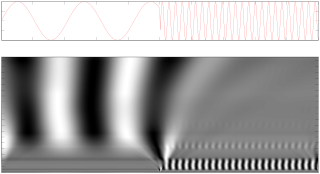Wavelet transform facts for kids
The wavelet transform is a time-frequency representation of a signal. For example, we use it for noise reduction, feature extraction or signal compression.
Wavelet transform of continuous signal is defined as
 = \frac{1}{\sqrt{a}}\int_{-\infty}^\infty{f(t)\psi^*\left(\frac{t-b}{a}\right)}dt\,](/images/math/0/c/e/0ced5930048da8f8ed1ccedaedbec774.png) ,
,
where
 is so called mother wavelet,
is so called mother wavelet, denotes wavelet dilation,
denotes wavelet dilation, denotes time shift of wavelet and
denotes time shift of wavelet and symbol denotes complex conjugate.
symbol denotes complex conjugate.
In case of  and
and  , where
, where  ,
,  and
and  and
and  are integer constants, the wavelet transform is called discrete wavelet transform (of continuous signal).
are integer constants, the wavelet transform is called discrete wavelet transform (of continuous signal).
In case of  and
and  , where
, where  , the discrete wavelet transform is called dyadic. It is defined as
, the discrete wavelet transform is called dyadic. It is defined as
 = \frac{1}{\sqrt{2^m}}\int_{-\infty}^\infty{f(t)\psi^*\left(2^{-m}t-kT\right)}dt\,](/images/math/d/c/b/dcb9ffd6edb6ccdf96785b5784b8b5a5.png) ,
,
where
 is frequency scale,
is frequency scale, is time scale and
is time scale and is constant which depends on mother wavelet.
is constant which depends on mother wavelet.
It is possible to rewrite dyadic discrete wavelet transform as
 = \int_{-\infty}^\infty{f(t) h_{m}\left(2^{m}kT-t\right)}dt\,](/images/math/f/5/9/f5909018d365ab3da3a5b29692debe15.png) ,
,
where  is impulse characteristic of continuous filter which is identical to
is impulse characteristic of continuous filter which is identical to  for given
for given  .
.
Analogously, dyadic wavelet transform with discrete time (of discrete signal) is defined as
![y_{m}[n] = \sum_{k=-\infty}^{\infty} f[k]h_{m}[2^{m}n-k]](/images/math/d/0/8/d08607acffd5b9ec0bdf0bc51ce24f22.png) .
.
Images for kids
See also
 In Spanish: Transformada ondícula para niños
In Spanish: Transformada ondícula para niños

All content from Kiddle encyclopedia articles (including the article images and facts) can be freely used under Attribution-ShareAlike license, unless stated otherwise. Cite this article:
Wavelet transform Facts for Kids. Kiddle Encyclopedia.


